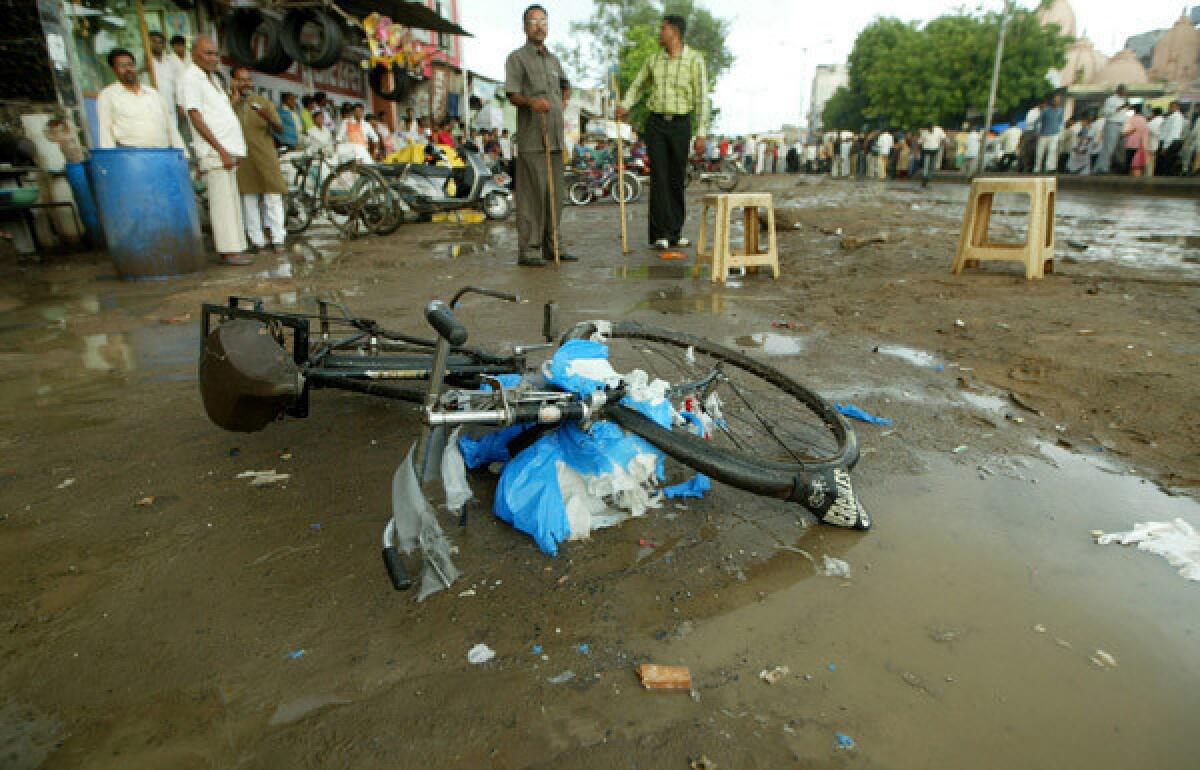Jailed engineers suspected of digging Indian prison tunnel

- Share via
NEW DELHI -- Jail officials in India’s western Gujarat state were conducting an investigation Tuesday after a 42-foot tunnel was discovered by chance under a high-security prison. It was reportedly excavated by convicted bombers with engineering degrees and found by a guard looking for unauthorized carrier pigeons.
Authorities found the tunnel on the northern side of a high-security chhota chakkar section of the Sabarmati Central Jail late Sunday. It had reportedly been excavated over several weeks by inmates using dishes, steel utensils, buckets, ropes and iron bars. Prisoners in this area are isolated from others and supposed to be under tight surveillance.
The plot was unearthed when a guard discovered that inmates had built carrier pigeon enclosures elsewhere and broadened his search, entering the chhota chakkar section unexpectedly and noticing two prisoners flee.
“He was looking out for contraptions to catch pigeons,” said P.C. Thakur, Gujarat’s inspector general of prisons. “He thought the prisoners might be using them to send messages.”
On closer examination, the guard found an entrance covered with dirt and cloth leading to a tunnel 16 feet underground, 26 feet long and two or three feet in diameter, just large enough for a person to wiggle through. A compass and makeshift lighting system were also discovered, added A.K. Sharma, a joint commissioner with the city’s crime branch.
India graduates tens of thousands of engineers each year, including some who end up on the wrong side of the law. The excavation reportedly involved three men, including a computer engineer and an electrical engineer overseen by civil engineer Hafiz Hussain Mulla.
“It’s very tragic that such educated persons go astray because of the wrong guidance at a young age,” said Thakur.
The three are part of a group of some five dozen people held in the Sabarmati jail in connection with a series of coordinated blasts on July 26, 2008, in Ahmedabad within a 70-minute period that killed 56 people and injured over 200.
Police say the suspects are members of the Indian Mujahedeen, which advocates for a society under Islamic law free from Western influence and which India has labeled a terrorist organization. The explosives were hidden in lunch containers aboard bicycles.
The prisoners had reportedly volunteered to start a garden in the prison grounds where they were able to dump sand and dirt extracted from the tunnel, reportedly transported using clothes and milk containers.
The Gujarat government has ordered an inquiry that would look into possible collusion by jail staff, according to media reports. Plans also call for the high-security area to be outfitted with closed-circuit TV cameras.
Indian prisons may look secure, but often suffer from weak internal management, critics said. “It’s about leadership,” said Kiran Bedi, former Delhi inspector general of prisons overseeing Tihar Jail, India’s largest. “Some prisons are left to the junior-most ranks, while the senior officials never visit. There are advisory boards, but they’re mostly surface-level.”
It’s unlikely that prisoners would be able to dig a relatively sophisticated tunnel without the complicity or negligence of prison staff, she said. High-security barracks should already have closed-circuit TV surveillance, she added, yet all too often authorities respond only when there’s a crisis.
“The politicians and bureaucrats divert money from budgets as long as they can,” Bedi said. “It’s like a mother who only feeds her child when it’s not only crying but disturbing the whole neighborhood.”
Sharma said newer prisons have better technology but Sabarmati was built in 1894 and maintenance has lagged. There are cameras at the main gate, but not in the high-security area where the tunneling occurred, he said. It’s also unclear what the inmates planned. They tunneled under a water tank, then changed directions, but the chhota chakkar section is surrounded by other wards some distance from the perimeter, which has a wall 21 feet high and up to 9 feet underground.
“We’re trying to take permission from the court to interrogate them, and if they confess, we can find out what they were thinking,” Sharma said. “This was all planned in a very intelligent manner.”
This is the latest in a series of high-profile prisoner escapes plots. In one of the more creative efforts, four accused murderers escaped high-security Burail Model Jail in Punjab in 2004 by digging a 94-foot tunnel under three walls and a road -- assisted by two power blackouts at the facility -- using their turbans as ropes and hiding the mouth of the tunnel under a wooden board on which carrots were growing. Two were recaptured and two remain at large.
At Sabarmati, however, Thakur placed some blame on the creaky wheels of Indian justice. The engineers’ case has been going on for more than four years -- proceedings are held inside the jail for added security -- with at least another year to go. “So they’ve languished, prompting them in sheer desperation to do this act,” Thakur said.
He downplayed the risk they might have escaped. “This is a jail built during British times, so it’s good and solid,” he said. “The digging was mainly in the soil area, not in buildings. It’s not like that film ‘Shawshank Redemption.’ ”
ALSO:
China condemns North Korea nuclear test
Acapulco rape case draws support for suspects
North Korea tested miniature nuclear device, state media says
Tanvi Sharma in New Delhi contributed to this report.
More to Read
Sign up for Essential California
The most important California stories and recommendations in your inbox every morning.
You may occasionally receive promotional content from the Los Angeles Times.










